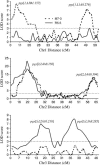Amplified fragment length polymorphism mapping of quantitative trait loci for malaria parasite susceptibility in the yellow fever mosquito Aedes aegypti
- PMID: 16624910
- PMCID: PMC1526673
- DOI: 10.1534/genetics.105.055178
Amplified fragment length polymorphism mapping of quantitative trait loci for malaria parasite susceptibility in the yellow fever mosquito Aedes aegypti
Abstract
The yellow fever mosquito Aedes aegypti has been the subject of extensive genetic research due to its medical importance and the ease with which it can be manipulated in the laboratory. A molecular genetic linkage map was constructed using 148 amplified fragment length polymorphism (AFLP) and six single-strand conformation polymorphism (SSCP) markers. Eighteen AFLP primer combinations were used to genotype two reciprocal F2 segregating populations. Each primer combination generated an average of 8.2 AFLP markers eligible for linkage mapping. The length of the integrated map was 180.9 cM, giving an average marker resolution of 1.2 cM. Composite interval mapping revealed a total of six QTL significantly affecting Plasmodium susceptibility in the two reciprocal crosses of Ae. aegypti. Two common QTL on linkage group 2 were identified in both crosses that had similar effects on the phenotype, and four QTL were unique to each cross. In one cross, the four main QTL accounted for 64% of the total phenotypic variance, and digenic epistasis explained 11.8% of the variance. In the second cross, the four main QTL explained 66% of the variance, and digenic epistasis accounted for 16% of the variance. The actions of these QTL were either dominance or underdominance. Our results indicated that at least three new QTL were mapped on chromosomes 1 and 3. The polygenic nature of susceptibility to P. gallinaceum and epistasis are important factors for significant variation within or among mosquito strains. The new map provides additional information useful for further genetic investigation, such as identification of new genes and positional cloning.
Figures



Similar articles
-
Restriction fragment length polymorphism mapping of quantitative trait loci for malaria parasite susceptibility in the mosquito Aedes aegypti.Genetics. 1995 Apr;139(4):1711-7. doi: 10.1093/genetics/139.4.1711. Genetics. 1995. PMID: 7789771 Free PMC article.
-
Population genetics of the yellow fever mosquito in Trinidad: comparisons of amplified fragment length polymorphism (AFLP) and restriction fragment length polymorphism (RFLP) markers.Mol Ecol. 1999 Jun;8(6):951-63. doi: 10.1046/j.1365-294x.1999.00647.x. Mol Ecol. 1999. PMID: 10434416
-
Aedes aegypti: a quantitative trait locus (QTL) influencing filarial worm intensity is linked to QTL for susceptibility to other mosquito-borne pathogens.Exp Parasitol. 1995 Nov;81(3):355-62. doi: 10.1006/expr.1995.1126. Exp Parasitol. 1995. PMID: 7498432
-
Progress in mapping the yellow fever mosquito genome.Tsitologiia. 2013;55(4):241-3. Tsitologiia. 2013. PMID: 23875456 Review.
-
Development and applications of transgenesis in the yellow fever mosquito, Aedes aegypti.Mol Biochem Parasitol. 2002 Apr 30;121(1):1-10. doi: 10.1016/s0166-6851(02)00028-2. Mol Biochem Parasitol. 2002. PMID: 11985858 Review.
Cited by
-
Genomic composition and evolution of Aedes aegypti chromosomes revealed by the analysis of physically mapped supercontigs.BMC Biol. 2014 Apr 14;12:27. doi: 10.1186/1741-7007-12-27. BMC Biol. 2014. PMID: 24731704 Free PMC article.
-
Mitotic-chromosome-based physical mapping of the Culex quinquefasciatus genome.PLoS One. 2015 Mar 13;10(3):e0115737. doi: 10.1371/journal.pone.0115737. eCollection 2015. PLoS One. 2015. PMID: 25768920 Free PMC article.
-
Identification of QTLs Conferring Resistance to Deltamethrin in Culex pipiens pallens.PLoS One. 2015 Oct 20;10(10):e0140923. doi: 10.1371/journal.pone.0140923. eCollection 2015. PLoS One. 2015. PMID: 26484540 Free PMC article.
-
Linkage disequilibrium and population structure in wild and domesticated populations of Phaseolus vulgaris L.Evol Appl. 2009 Nov;2(4):504-22. doi: 10.1111/j.1752-4571.2009.00082.x. Epub 2009 Jul 3. Evol Appl. 2009. PMID: 25567895 Free PMC article.
-
Imaginal discs--a new source of chromosomes for genome mapping of the yellow fever mosquito Aedes aegypti.PLoS Negl Trop Dis. 2011 Oct;5(10):e1335. doi: 10.1371/journal.pntd.0001335. Epub 2011 Oct 4. PLoS Negl Trop Dis. 2011. PMID: 21991400 Free PMC article.
References
-
- Abraham, E. G., and M. Jacobs-Lorena, 2004. Mosquito midgut barriers to malaria parasite development. Insect Biochem. Mol. Biol. 34: 667–671. - PubMed
-
- Alavi, Y., M. Arai, J. Mendoza, M. Tufet-Bayona, R. Sinha et al., 2003. The dynamics of interactions between Plasmodium and the mosquito: a study of the infectivity of Plasmodium berghei and Plasmodium gallinaceum, and their transmission by Anopheles stephensi, Anopheles gambiae and Aedes aegypti. Int. J. Parasitol. 33: 933–943. - PubMed
-
- Antolin, M. F., C. F. Bosio, J. Cotton, W. Sweeney, M. R. Strand et al., 1996. Intensive linkage mapping in a wasp (Bracon hebetor) and a mosquito (Aedes aegypti) with single-strand conformation polymorphism analysis of random amplified polymorphic DNA markers. Genetics 143: 1727–1738. - PMC - PubMed
-
- Bassam, B. J., G. Caetano-Anolles and P. M. Gresshoff, 1991. Fast and sensitive silver staining of DNA in polyacrylamide gels. Anal. Biochem. 196: 80–83. - PubMed
-
- Beernsten, B. T., D. W. Severson, J. A. Klinkhammer, V. A. Kassner and B. M. Christensen, 1995. Aedes aegypti: a quantitative trait locus (QTL) influencing filarial worm intensity is linked to QTL for susceptibility to other mosquito-borne pathogens. Exp. Parasitol. 81: 355–362. - PubMed
Publication types
MeSH terms
Substances
Grants and funding
LinkOut - more resources
Full Text Sources
Miscellaneous

